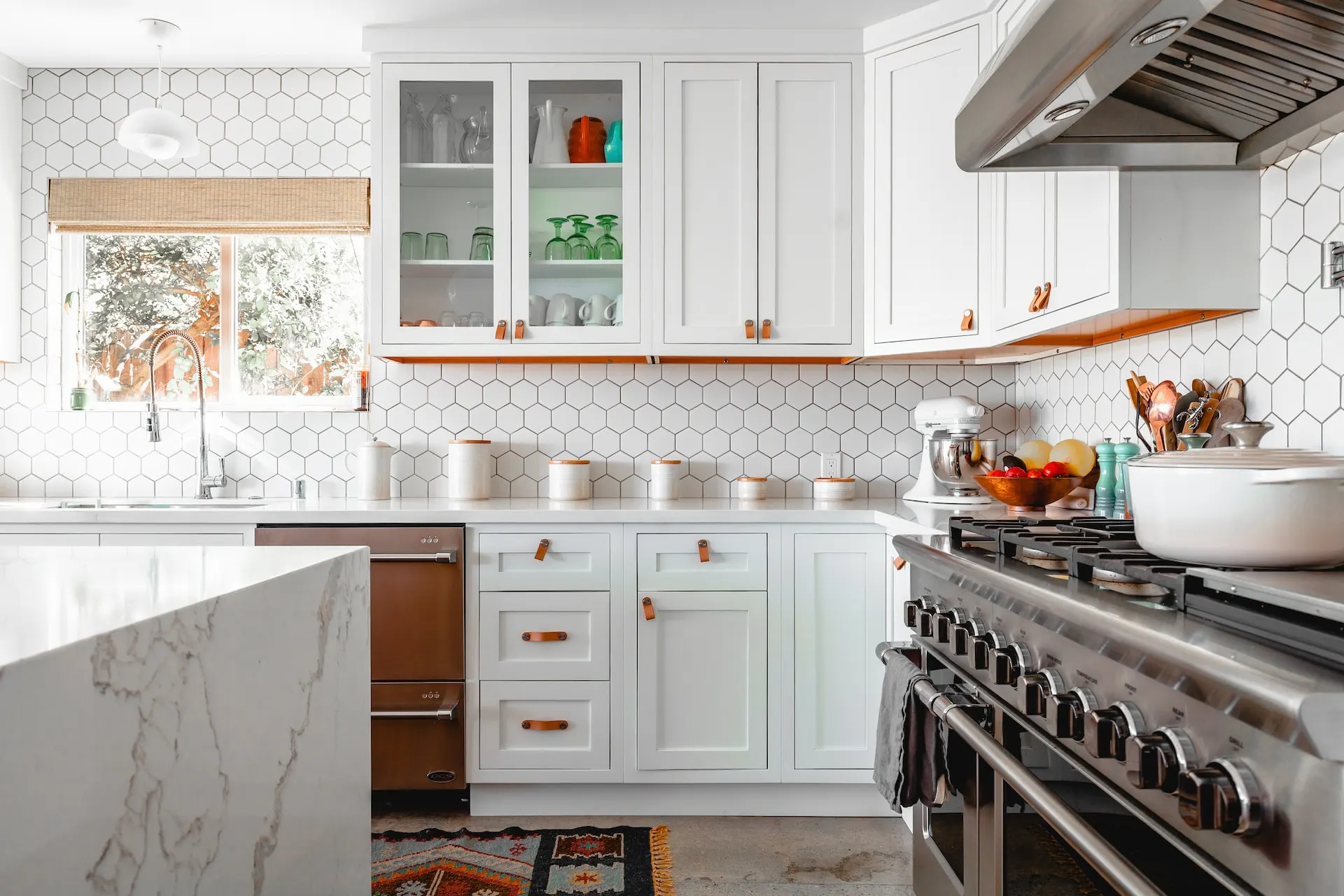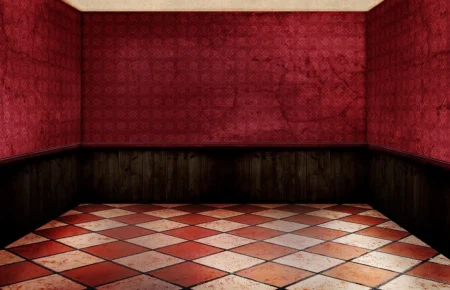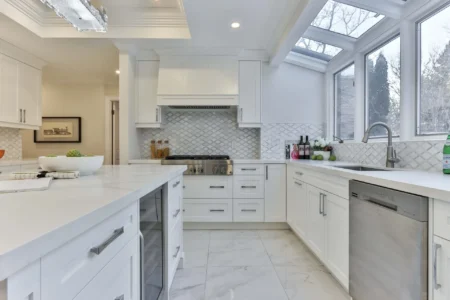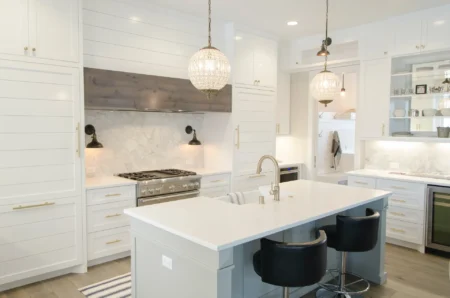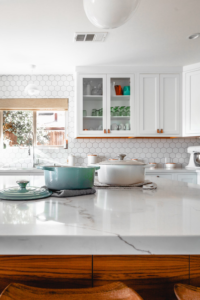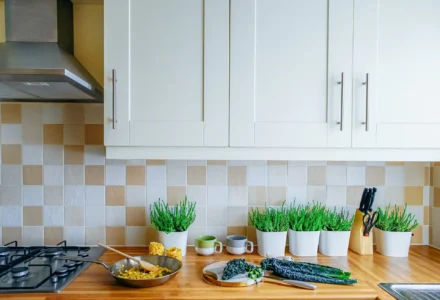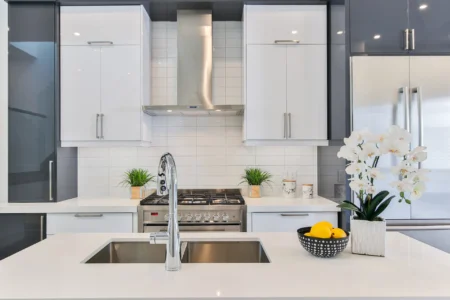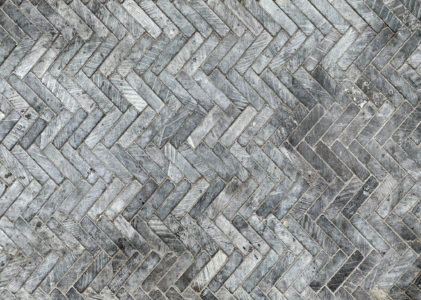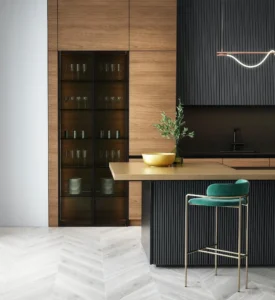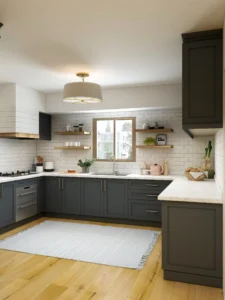It might be difficult to choose the correct tile for the wall behind your stove. It’s easy to get lost in the sea of possibilities. The perfect tile, however, may do more than just safeguard your walls from spills and stains; it can also elevate the look of your kitchen. This post will help you select the ideal tile for the wall behind your range.
The Benefits of Tiling Behind the Stove
Backsplash tiles, which are installed behind the stove, have a functional as well as aesthetic purpose. It has a number of utilitarian and aesthetic uses that may improve your kitchen as a whole.
- Protection: Backsplashes are used in kitchens to prevent water damage to walls from splashes, spills, and stains caused by food preparation and cleaning. Tiles are a great material for this high-traffic area since they are so simple to clean and maintain.
- Heat Resistance: Tiles, especially ceramic and porcelain tiles, can withstand high temperatures without cracking or melting. This means that they are resistant to the high temperatures produced by your stove, protecting your kitchen walls from any blemishes or discoloration.
- Style Statement: The right tile may make a bold fashion statement in your home’s kitchen. The appropriate tile may reflect your unique style and elevate the overall appearance of your kitchen, whether you choose traditional subway tiles, a colorful mosaic, or a contemporary geometric design.
- Increased Home Value: The value of your property may be considerably increased by creating a beautiful and functional kitchen. If you ever decide to put your house up for sale, a trendy backsplash may help you attract more interested buyers by making your kitchen look more modern and put together.
- Easy to Update: Because they can be easily replaced, tiles are a good choice if you like to give your kitchen a new appearance every few years. You can easily and cheaply give your kitchen a new look by just replacing the cabinets.
In the following paragraphs, we’ll discuss the specifics of making a tile selection for your backsplash.
What to Look for in a Tile Backsplash
Selecting the ideal tile for your backsplash goes beyond simply selecting a visually appealing pattern. Choosing tile for your kitchen that not only looks excellent but also functions well requires careful consideration of a number of aspects.
- One of the most important considerations is the tile’s substance. The appearance and functionality of various materials vary greatly. Because they can withstand high temperatures without breaking, ceramic and porcelain tiles are frequently used. Using glass tiles in your kitchen may give it a contemporary and sophisticated aesthetic, but they may require additional upkeep. Granite and marble tiles, for example, have a traditional and enduring look, but they may need to be sealed to avoid stains.
- Dimensions and form: There is a wide range in the size and form of tiles available. How your kitchen turns out depends greatly on the dimensions and shape of your cabinets. In a tiny kitchen, larger tiles can provide the illusion of more space, while smaller tiles can be used to create a more detailed backsplash.
- The color and pattern of your tile can either match or stand in sharp contrast to the rest of your kitchen’s decor. A tile with a bold pattern may liven up a kitchen with a minimalist design that uses only a few colors. Conversely, a plain, neutral tile might serve as a counterpoint to an otherwise bright kitchen.
- Upkeep: Not all tiles are created equal when it comes to upkeep. While ceramic and porcelain tiles may be easily cleaned with water and a light detergent, real stone tiles may need to be sealed regularly to avoid stains. Think about how much time and effort you’re willing to put into tile upkeep before making a final decision.
- Budget: One final thing to think about is cost. Tiles come in a broad range of prices due to factors including their material, size, and design. It’s important to find tiles that meet your budget without sacrificing beauty or quality.
Now that we’ve discussed what to look for in a tile backsplash, let’s talk about how to coordinate it with the rest of your kitchen’s aesthetic.
How to Match Your Tile Backsplash with Your Kitchen Design
Although it may seem like a lot of work, you can easily coordinate your tile backsplash with the rest of your kitchen’s decor. With enough forethought and research, you may choose a tile that not only complements your kitchen’s aesthetic but really elevates it.
- Consider the Color Scheme: Your kitchen’s current color scheme should be considered while choosing a backsplash color. To spice up a kitchen with muted tones, try installing a backsplash with a bold accent color. If your kitchen is already brightly colored, though, a neutral backsplash may be more appropriate.
- Think About the Style: Your kitchen’s decor should play a role in determining the backsplash you choose. If your kitchen is contemporary, for instance, you may choose for a tile pattern that features simple geometric shapes. Subway tiles or natural stone tiles are great options for a classical kitchen.
- Factor in the Countertops: You should also think about your counters while making your backsplash selection. If your kitchen’s countertops are patterned or otherwise busy, a simpler backsplash may be in order. If your countertops are on the plain side, a more intricate backsplash may be just what you need to spice things up.
- Don’t Forget the Cabinets: Think about what you want your cabinets to look like and what color they will be. A kitchen with dark cabinetry might benefit from a brighter backsplash. A black backsplash may provide a nice contrast to light cabinetry.
- Remember the Lighting: Finally, think about the kitchen’s lighting. A brighter, reflecting backsplash might help lighten a kitchen that doesn’t get a lot of natural sunlight. If your kitchen is well-lit, you may choose from a wider variety of backsplash materials.
Next, we’ll discuss which tile material is best for behind the stove.
Which Tile Material is Best for Behind the Stove?
High temperatures and splatters from cooking frequently affect the space behind the stove. Because of this, you’ll want to make sure that the tile you use here is long-lasting, resistant to heat, and simple to maintain. The finest tile options for the wall behind the range are as follows:
- Ceramic and Porcelain: Tiles made of ceramic and porcelain are frequently used as kitchen backsplashes because of their longevity, resilience to heat, and low maintenance requirements. They allow you to personalize your backsplash because of the variety of colors, designs, and materials available. When compared to ceramic tiles, porcelain ones are more stain- and wear-resistant since they are denser and less porous.
- Glass: Tiles made of glass give your kitchen a sophisticated appeal. They won’t soak up liquids or discolor easily. However, they tend to show fingerprints and smudges more than other materials do, so they may need to be cleaned more frequently.
- Natural Stone: Tiles made from natural stones like granite, marble, or slate provide an elegant and sophisticated appearance. They can withstand high temperatures without breaking down. However, if not properly sealed, they will absorb stains. As a result, they need more upkeep than other tile options like ceramic and glass.
- Metal: Metal tiles, such as copper or stainless steel, may give your kitchen a modern, industrial look. They can withstand high temperatures without breaking down and are simple to maintain. However, they are easily scratched and could need specialized cleaning supplies.
- Quartz: If you’re searching for a low-maintenance, long-lasting material, quartz tiles are a fantastic choice. They don’t absorb moisture or stains and come in many different hues and designs. They are beautiful, but the price might be more than that of other tile options.
The tile you put behind your stove should reflect your personality, the necessities of your kitchen, and your budget.
Conclusion
The kitchen tile you choose for the wall behind your stove has a major influence on the look and feel of your kitchen. Choosing a kitchen tile should involve more than simply aesthetics; you also need to think about its heat resistance, longevity, and maintenance friendliness. This decision can significantly impact the overall functionality and style of your kitchen space.
Frequently Asked Questions (FAQs)
What should I put behind my stove?
A tile backsplash, for example, would look great behind your stove. You can cook without worrying about damaging your walls or getting food stains on the wall. Depending on your budget and the theme of your kitchen, you can choose from ceramic, porcelain, glass, natural stone, metal, or quartz.
Should you tile behind a stove?
Yes, tiling behind a stove is highly recommended. Tiles are heat-resistant, easy to clean, and can significantly enhance the aesthetics of your kitchen. They also protect your wall from heat, grease, and food splatters, making maintenance easier.
What is the tile behind the stove called?
In tile terms, the area behind the range is known as the "backsplash." In addition to shielding the wall from damage caused by cooking heat and spills, it also looks nice and enhances the room's visual appeal.
How do I keep my tile behind my stove clean?
The tile in your backsplash will last longer if you clean it regularly. Tiles should be cleaned regularly with a moist cloth to get rid of splashes and stains. Use a light detergent or a vinegar-water solution for a more in-depth cleaning. To protect the tile's surface, never use abrasive cleansers. To keep them from being stained, natural stone tiles may need to be sealed on a regular basis.
